|
|
Post by Samba on Dec 29, 2016 12:43:48 GMT 1
I finally caught the Patsy Leigh interview on her life as a Starways stewardess this morning on Merseyside, for anyone who hasn't read the book yet, it's a nice story of how flying used to be well before the age of mass travel. Bob. |
|
Deleted
Deleted Member
Posts: 0
|
Post by Deleted on Dec 29, 2016 14:28:38 GMT 1
I finally caught the Patsy Leigh interview on her life as a Starways stewardess this morning on Merseyside, for anyone who hasn't read the book yet, it's a nice story of how flying used to be well before the age of mass travel. Bob. Yes, having also read it, I would second that. |
|
|
|
Post by lambert7 on Feb 23, 2017 17:09:38 GMT 1
My father Derek Lambert flew for Starways from Speke in 1951 as a first officer with Captains Rodnight & Dean amongst others and often made the Belfast run in the DC3 "DG" before joining British European Airways later that year
|
|
|
|
Post by viscount on Jun 19, 2023 9:23:55 GMT 1
STARWAYS IMAGES: DAKOTAS  G-AMJU Dakota 4. The 'letter box' format, cut with scissors shows that this has once been used in MAS 'Flypast' magazine. G-AMJU served with Starways from 1955 until February 1958.  G-AMPO Dakota 4, along with G-ARIR at the east end of the terminal building. Sometime after February 1961. 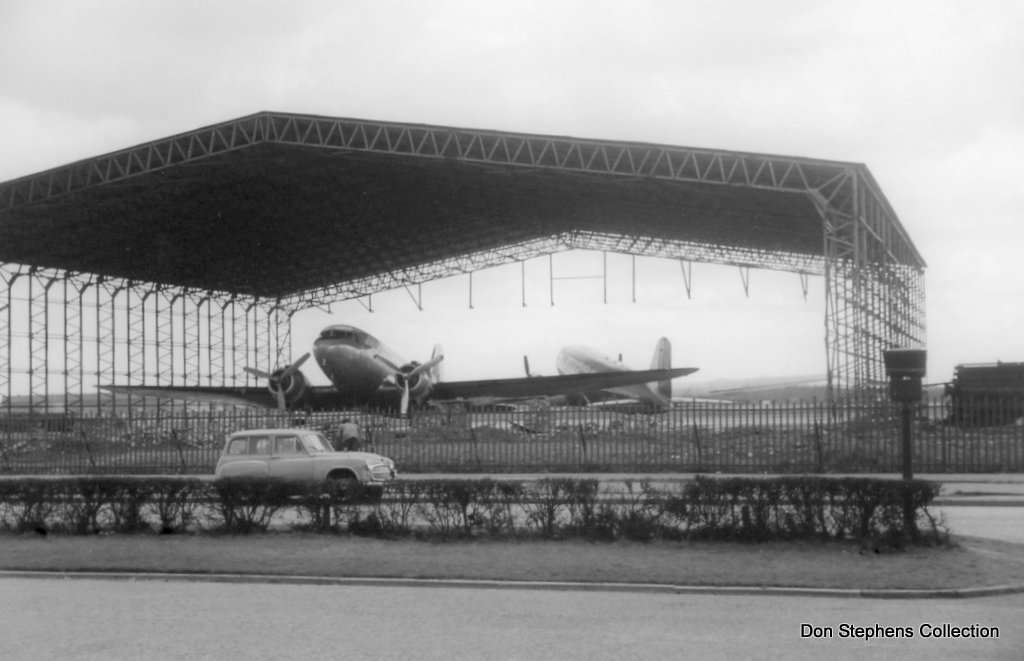 Two Dakotas sheltering inside the frame of an incomplete hangar. Likely sometime 1963.  G-AMPY, Dakota 4. An MAS Photo Service photo, so the original photographer is unknown  G-AMPY, Dakota 4, outside the Starways hangar alongside Speke Road/Boulevard. 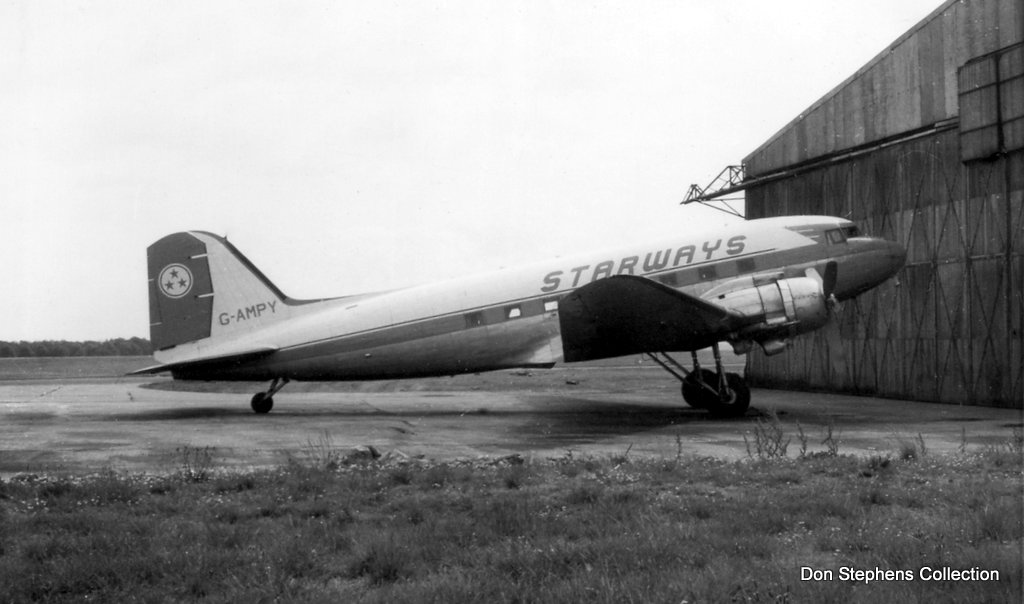 G-AMPY Dakota 4. Photo dated 6th June 1960.  G-AMPY Dakota 4. An MAS Photo Offer print. Date or the original photographer, unrecorded.  G-AMSN Dakota 4 in the later Starways Dakota scheme, now with blue rudder and white logo.  G-AMSN Dakota 4. Photo also dated 6th June 1960.  G-AMSN Dakota 4. Photo dated 25th June 1961  G-AMSN Dakota 4. Dated 30th May 1963, which was the day before the 1963 Air Display - which explains all the activity out on the airfield.  Despite this not being a Liverpool shot, this wonderfully crisp photo of G-AMSN deserves to be seen. As a footnote, if I recall correctly, radial piston engines were much happier if stopped and started into wind. With prevailing winds from the west, then usually the aircraft were parked left to right on the apron (as seen from the balcony). With a much less frequent easterly wind, they were occasionally parked the other way around (as demonstrated by the penultimate photo of the sequence!). |
|
|
|
Post by ronturner on Jun 19, 2023 10:10:35 GMT 1
Thanks for posting these images. I don't think I ever saw 'JU. If I did, I never logged it.
This post also served as a reminder to order Patsy's book, which I just did.
|
|
|
|
Post by viscount on Jun 20, 2023 10:15:06 GMT 1
STARWAYS IMAGES: SKYMASTERS Starways operated 6 Skymaster aircraft in all, the first arriving September 1957, with 3 in service when operations closed at the end of December 1963. Their first aircraft was a Douglas DC-4 (G-APEZ), built for the civil market immediately after WW II, the others all saw military service (as Douglas C-54s) prior to sale and civilianisation.  A Post Card from the Phil Dale collection, scanned and sent to Don Stephens who kept it on download. A print that certainly captures the '60s period feel. 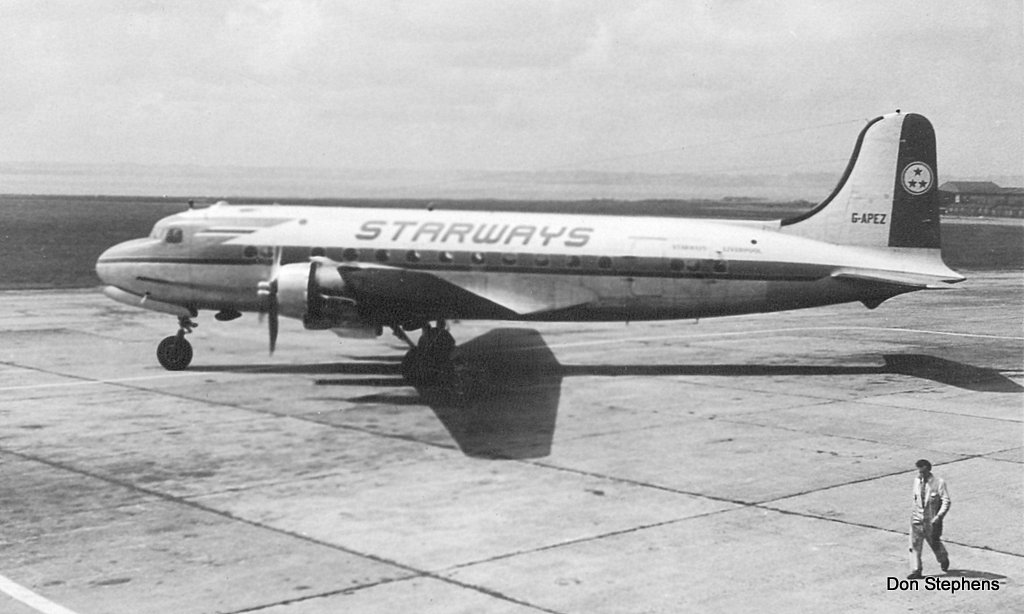 Douglas DC-4 Skymaster G-APEZ. The youngest Skymaster in the fleet, built April 1946. Probably a PH Butler photo from 1958.  While this is a great shot from the upper level of Speke's balcony.   More of Douglas DC-4 G-APEZ  Douglas C-54D Skymaster G-APIN. Not come across too many shots of G-APIN until in 'UNO' markings during 1961. 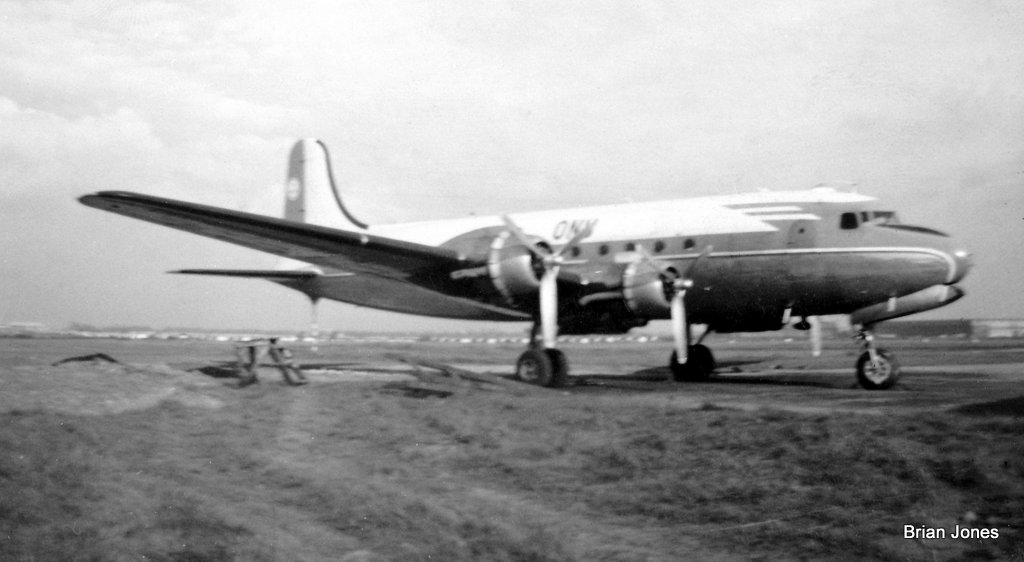 Summer 1961, while parked out parallel to Speke Road, quite likely within a day or two of the previous photo. This shot is with a basic Brownie 127 camera (no focus, no aperture, constant shutter speed)  Douglas C-54A Skymaster converted to Douglas DC-4 standard by Pennsylvania Central Airlines in 1946. This shot of G-APYK is dated as taken on 13th April 1960. 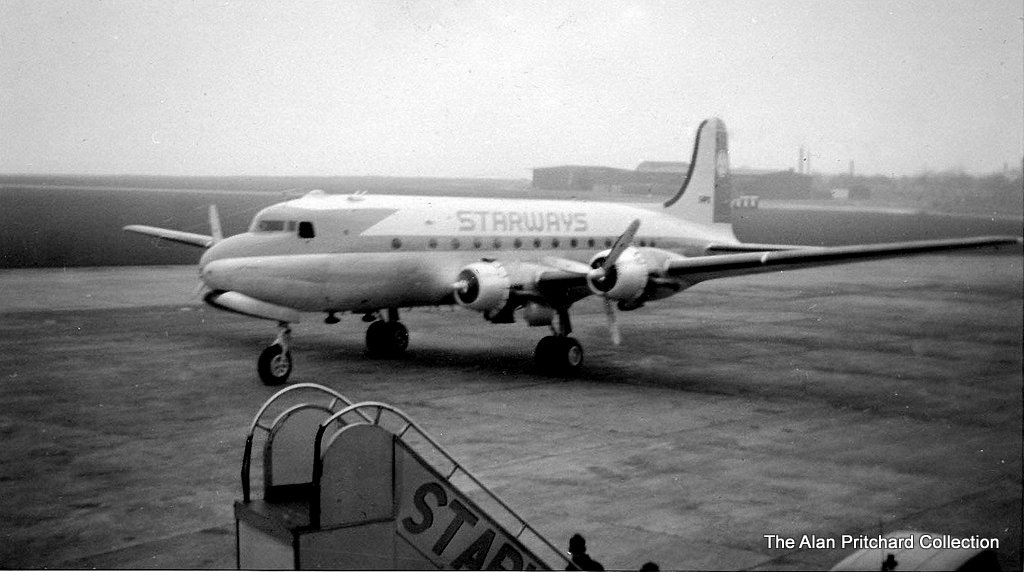 G-APYK Douglas C-54A Skymaster G-APYK  Douglas C-54/DC-4 Skymaster G-ARIY seen on 25th August 1962. By build date, the oldest of the Starways Skymasters having been delivered to the USAF in September 1942 and converted to Douglas DC-4 standard by Pennsylvania Central Airlines in 1946. 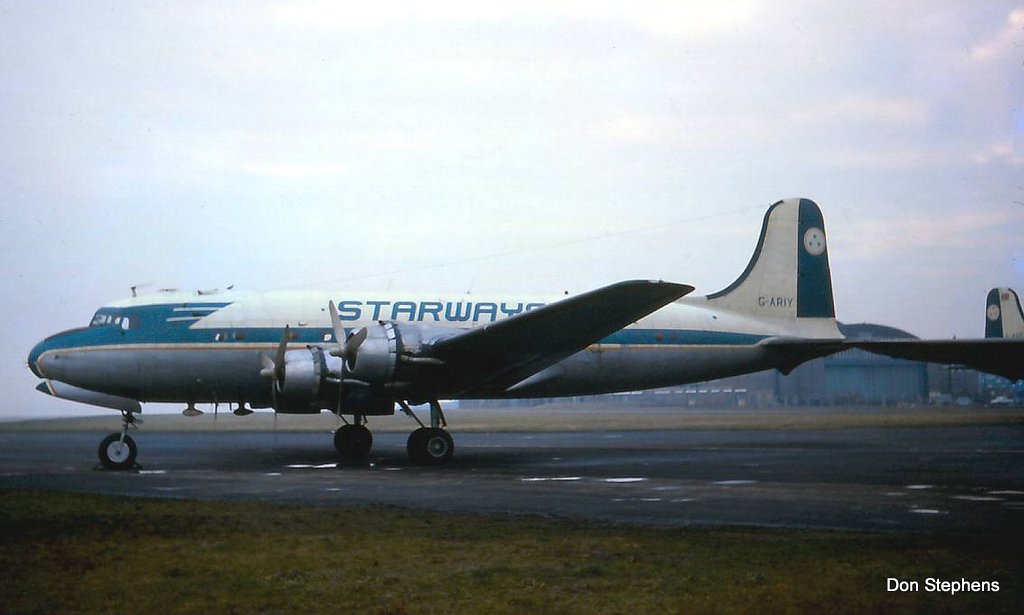 G-ARIY in colour  G-ARIY outside number 2 hangar receiving attention to an engine on the apron between flights.  Built as a Douglas C-54A Skymaster this aircraft was converted to a Douglas DC-4 standard by Douglas for United Air Lines. Here as G-ARJY in February or March 1961 shortly after arrival at Liverpool from Pacific Southwest Airlines. This aircraft never had the Starways scheme and tail logo on a blue rudder applied. Mind you, service with Starways was only brief as the aircraft suffered an undercarriage up landing at Dublin in September 1961.  Built as a Douglas C-54A Skymaster this aircraft was converted to a Douglas DC-4 standard by Douglas for Pan American. G-ASEN shortly after arrival on delivery from Cathay Pacific Airways at Hong Kong in January 1963. On the final leg into Liverpool the starboard outer engine has 'shed' the whole propeller unit, the landing being made on 3 engines as a result.  A couple of days later and, now parked on the Western apron, G-ASEN has had the whole starboard outer engine removed for inspection.  A professionally processed scan and print of Starways G-ASEN at a rather wet Manchester. |
|
|
|
Post by viscount on Jun 20, 2023 14:19:57 GMT 1
STARWAYS IMAGES: THE VISCOUNTS  G-APZB was the second V.707 Viscount in service with Starways and was with them just over a year. It had previously flown with Aer Lingus and Tradair.  Although wearing fresh 'Starways' titles (in a different font than the Dakotas and Skymasters) it still wore F-BGNS and the fuselage cheat-line of its previous operator Air France. Circa February 1961.  G-ARIR V.708 Viscount during June 1963.  A little distant and overexposed, G-ARIR sat on disused taxi-way close to the Starways hangar as seen from Speke Road. Clear here is the large 'French' style of registration presentation, as compared to the smaller, within the cheat-line, presentation applied on G-APZB some years later.  An 'arty' John Mills photo of G-ARIR framed by by the engine of another, with Liverpool's distinctive terminal beyond.  More correctly this shot of V.701 Viscount G-AMOC is in the British Eagle section. After the purchase of the rights to operate Starways scheduled routes and charter contracts for a while until the route licence changes were fully approved by the ATLB (Air Transport Licencing Board), from 1st January 1964 until sometime around May, a few of the British Eagle colour schemed Viscounts wore 'Starways' roof titles. * * * * * * * * * * * That completes a June 2023 revamp of this nostalgia section thread relating and illustrating the history of Starways, along with Aviation Overhauls and Trans-Meridian's early years. I have agonised over whether to simply delete forever the photo posts mutilated by Photobucket or to leave them in place. A fair number of images I have been able to replace, and have moved a few around between posts to be in a more relevant position. There remains a couple posts where the poster no longer contributes and sadly one post where the the member has since passed away. Despite being a 'zombie thread' since 2018 with watermarked images, since the first post at the end of July 2010 the thread has accumulated a quite remarkable 23,850 visits. This makes it one of the most visited 'single topic' threads on NWAN Forum. Many visitors likely finding the thread on a 'google' of the subject. The whole thread is now well worthy of a revisit with well over 50 images either restored or added. Sit back, scroll through and enjoy. If you have more to add, feel free to share your knowledge and images. There is an index linking to all 50+ Liverpool based airlines and operators. Some have images refreshed, the others I am working through as time permits. |
|
Deleted
Deleted Member
Posts: 0
|
Post by Deleted on Jun 21, 2023 0:14:40 GMT 1
As an appendix to Viscount's excellent update, and with his knowledge, I have posted a story, which briefly traces the history of Starways, but more importantly, the story of G-APIN which was written off in what was then The Belgian Congo whilst in service with the United Nations. The Sad Story of 'India November': Starways began as an airline in Blackpool in 1948, formed by two pilots, Noel Rodnight and Albert Dean. Their plan was to operate a charter service for celebrities who regularly appeared in the shows there, in the days when Blackpool was an extremely popular holiday resort. Thus the name Starways was chosen. For this purpose, they used a G-AFIX, a twin-engined four-seat feeder aircraft known as the Percival Petrel, which was purchased on 7 January 1949. Just a few months later, on 6 May 1949, the aircraft was damaged beyond repair near Broom Hall Airfield Pwllheli in North Wales, whilst on a flight from Blackpool. Curiously, the registration was not cancelled until ten years later. Starways replaced it with an Avro Anson Mk 1, G-ALIH, leased from another Blackpool operator, Air Navigation and Trading, and a further Anson G-AIRN, but the base was moved to Liverpool in 1950 and the Wilson family became major shareholders in the fledgling airline. The family owned a chain of clothing stores selling surplus military uniforms and other equipment, large amounts of which had become available at the end of World War Two. By 1954, the family had full control of the airline, and began a significant expansion plan. Previously, there had been only a flight to London, but the Wilsons bought a number of DC-3s and began to expand the network to Glasgow, Cork, and a summer operation to Newquay. They also began to operate what became known as inclusive tours, for which the hotel accommodation and the airfare were sold as one item, to continental European destinations, such as Dinard, Ostend, and Lourdes. Such was the response to these flights, that in 1957, the airline purchased its first DC-4, G-APEZ. Several others followed, one of which was G-APIN, which had previously been owned by Transocean Airlines, based in Oakland California. It was received in January 1958. The inclusive tour business was a novelty at the time, and therefore financially rewarding, but in those days, very seasonal. The Wilsons looked around for other ways to use the aircraft, particularly the DC-4s, during the winter, and found work for the aircraft and crews through the United Nations, which at that time was supporting operations in what had formerly been the Belgian Congo, now officially known as the Democratic Republic of the Congo. Following its declaration of independence in 1960, and in order to maintain stability among the various factions within the country, on 17 July 1960, the United Nations adopted a Security Council Resolution, allowing it to provide military assistance to the Congolese forces. The breakaway faction of Katanga province was unhappy with this, and began to mobilise forces to oppose the UN presence. This led to an uprising within the country, during which various factions, some backed by the Soviet Union and others by the Western powers, began to battle for control. Katanga recruited mercenary pilots and acquired a number of aircraft from various sources, including Fouga CM.170 Magisters which were ordered from France. In fact, nine had been ordered, but only three were delivered. Starways was awarded a contract to provide assistance to the UN and was contracted to supply DC-4s on a charter basis to support the operation, known as ONUC, for several months at a time The aircraft were normally based at Kamina airport in the south of the country, a large former Belgian military base which had been set up after World War Two. The aircraft used for the operation would be rotated amongst the fleet. They carried the simple title ONU, (the French version of UNO - United Nations Organisation) on the roof. They would carry both passengers and freight around the country, as required. G-APIN had been chosen to fulfill the charter operation in Kamina in early September 1961. Normally, two engineers and four pilots would travel with the aircraft. The air base at Kamina was run and secured by the United Nations and only official personnel were allowed onto the base. The aircraft, when not being used, would be parked on the massive dispersal areas near the hangars. When the crew locked up G-APIN on the night of 15th September before returning to their hotel, they could not have imagined the sight that would greet them the next morning. Early in the morning of 16 September 1961, Kamina airport had been attacked by a Fouga Magister belonging to the rebel Katanga Air Force, and G-APIN was destroyed. The UN had not expected an attack from the air and there were no anti-aircraft emplacements. All concerned were surprised by the sheer scale of destruction, even taking into account the residual fuel in India November’s tanks, and it seems likely that the Magister would have made more than one pass to inflict that level of damage, and that possibly a 100lb bomb was used; India November was a sitting duck. On 13 September, a DC-3, also bearing the UN titles and registered UN-209, which had previously been KJ 896 of the RAF and later 0-348666 with the US Military Air Transport Service, had been attacked and destroyed whilst on the ground at Elisabethville (now Lubumbashi). The day before the India November incident, another DC-4, OO-ADN, carrying the titles of Air Katanga, was attacked and destroyed on the same airfield. Photos of the damage show remarkable similarities with that of India November. Fortunately, since the attacks took place at night, there were no injuries to personnel working there. September 1961 was a bad month for Starways. Another DC-4, G-APYK, was written off in a wheels-up accident in Dublin just three days later, on 19 September. Starways was absorbed into British Eagle on November 1963, with the last flight taking place on 31 December 1963. The photos of the remains of G-APIN were taken by Bernie McKenzie, a Starways engineer, who was working there at the time. The other two photographs are mine.      |
|
|
|
Post by ronturner on Jul 5, 2023 9:26:49 GMT 1
|
|